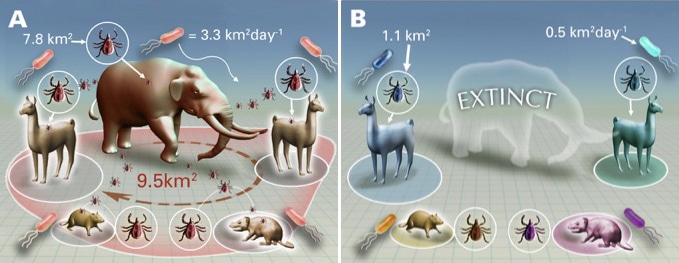What if pandemics could be stopped before they start?
A recently published paper in Ecography suggests that ambitious question isn’t so far-fetched.
Chris Doughty, assistant professor in the School of Informatics, Computing, and Cyber Systems at Northern Arizona University and lead author on the paper “Megafauna decline have reduced pathogen dispersal which may have increased emergent infectious diseases,” has long studied megafauna and their role on planet Earth. With the world fighting the spread of COVID-19, Doughty and his team have turned to these large mammals for answers. New data suggests that in addition to their extinction drastically reducing the distribution of nutrients and seeds, it also may have impacted the distribution and formation of infectious diseases. In other words, without large-mammals to disperse parasites and pathogens across the landscape, pathogens were forced to adapt—eventually jumping to and infecting humans and their domestic animals.
“The large, free-ranging mammals that once inhabited most of Earth’s surface transported with them a variety of pathogens and microbes, such as ticks on the skin and E. coli in the gut,” Doughty said. “This new study shows that as large animals went extinct, their dispersal services were lost and the ability of pathogens to travel across the landscape reduced sevenfold.”
Using this data, the authors linked parts of the planet where pathogens lost the most mobility to locations where infectious diseases like Ebola have jumped from wildlife into human populations. Understanding where these jumps occurred will allow researchers to predict where future outbreaks may arise and target surveillance to these regions, potentially reducing the risk of a new pathogen spreading widely in the human population before countermeasures can be put in place.
The paper hypothesizes that the extinctions of these mammals led to a significant disruption of parasite and pathogen movement, increasing the emergence of zoonotic infectious diseases in humans. The largest animals have the largest home ranges and gut lengths, and their removal began a process of isolating pathogens.
“These extinctions caused a profound disequilibrium in nature,” Doughty said. “For instance, we’ve calculated it would have taken a generalist tick 70 times as long to travel across parts of South America following the extinctions since all 26 animals larger than 1,000 kg have gone extinct there.”
Models used in the study showed that such a reduction of movement would have isolated pathogens and allowed them to diversify over the next 10,000 years.
“The reason why infectious diseases jump into humans for the first time is complicated and multifaceted,” said coauthor and graduate student Tomos Prys-Jones, who is studying ecoinformatics. Previous studies have correlated the emergence of infectious disease to high human population densities, temperature, precipitation and wildlife biodiversity. “This study is novel because it incorporates quantitative information on past extinctions into these models and accounts for the profound ecological disequilibrium they caused. These results have opened up new avenues of inquiry and we are currently looking at how the migration of present-day species shapes microbe transmission and evolution.”
By analyzing this information, the team created an improved map predicting locations of potential future infectious disease outbreaks. Then they quantitively predicted the cost of these prior extinctions in terms of human diseases. Their model suggests that between 5 and 8 percent of the 145 recorded zoonotic diseases may be attributed to the past extinctions of large mammals.
“Large animals are keystone elements in ecosystems and provide many unique ecosystem services, including the potential to reduce the risk of disease outbreaks, but they also are vulnerable to extinction threats due to high levels of human persecution, their low fecundity and large space needs,” said Jens-Christian Svenning, professor at Aarhus University’s Center for Biodiversity Dynamics in a Changing World and coauthor of the paper.
“Future preservation and restoration of the remaining large animals could potentially reduce the risk of novel diseases emerging in the future,” Doughty said.

(928) 523-5582 | carly.banks@nau.edu



